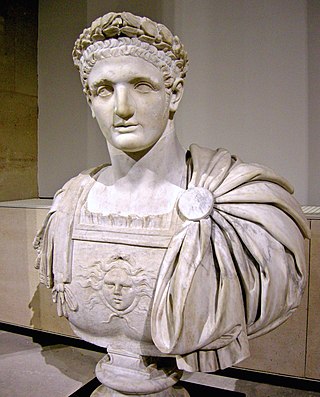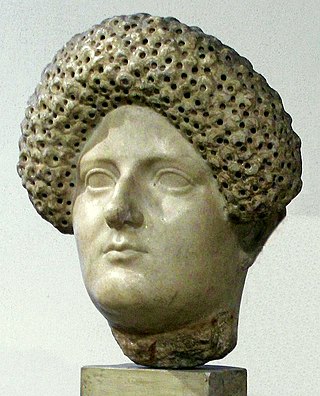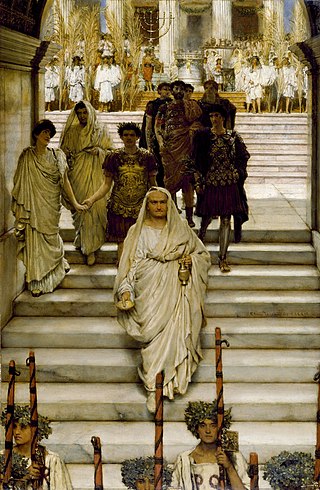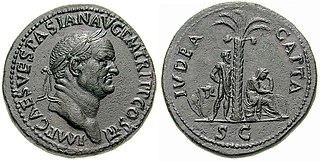Related Research Articles

Domitian was Roman emperor from 81 to 96. The son of Vespasian and the younger brother of Titus, his two predecessors on the throne, he was the last member of the Flavian dynasty. Described as "a ruthless but efficient autocrat", his authoritarian style of ruling put him at sharp odds with the Senate, whose powers he drastically curtailed.

The 90s was a decade that ran from January 1, AD 90, to December 31, AD 99.

Titus Caesar Vespasianus was Roman emperor from 79 to 81. A member of the Flavian dynasty, Titus succeeded his father Vespasian upon his death, becoming the first Roman emperor to succeed his biological father.

The Arch of Titus is a 1st-century CE honorific arch, located on the Via Sacra, Rome, just to the south-east of the Roman Forum. It was constructed in c. 81 CE by Emperor Domitian shortly after the death of his older brother Titus to commemorate Titus's official deification or consecratio and the victory of Titus together with their father, Vespasian, over the Jewish rebellion in Judaea.

Domitia Longina was a Roman empress and wife to the Roman emperor Domitian. She was the youngest daughter of the general and consul Gnaeus Domitius Corbulo. Domitia divorced her first husband, Lucius Aelius Lamia Plautius Aelianus in order to marry Domitian in AD 71. The marriage produced only one son, whose early death is believed to have been the cause of a temporary rift between Domitia and her husband in 83. She became the empress upon Domitian's accession in 81, and remained so until his assassination in 96. She is believed to have died sometime between AD 126 and 130.

The Flavian dynasty, lasting from AD 69 to 96, was the second dynastic line of emperors to rule the Roman Empire following the Julio-Claudians, encompassing the reigns of Vespasian and his two sons, Titus and Domitian. The Flavians rose to power during the civil war of AD 69, known as the Year of the Four Emperors; after Galba and Otho died in quick succession, Vitellius became emperor in mid 69. His claim to the throne was quickly challenged by legions stationed in the eastern provinces, who declared their commander Vespasian emperor in his place. The Second Battle of Bedriacum tilted the balance decisively in favor of the Flavian forces, who entered Rome on 20 December, and the following day, the Roman Senate officially declared Vespasian emperor, thus commencing the Flavian dynasty. Although the dynasty proved to be short-lived, several significant historic, economic and military events took place during their reign.

The Siege of Jerusalem of 70 CE was the decisive event of the First Jewish–Roman War, in which the Roman army led by future emperor Titus besieged Jerusalem, the center of Jewish rebel resistance in the Roman province of Judaea. Following a five-month siege, the Romans destroyed the city and the Second Jewish Temple.

The Flavian Palace, normally known as the Domus Flavia, is part of the vast Palace of Domitian on the Palatine Hill in Rome. It was completed in 92 AD by Emperor Titus Flavius Domitianus, and attributed to his master architect, Rabirius.

The Ludus Magnus, also known as the Great Gladiatorial Training School, was the largest of the gladiatorial schools in Rome. It was built by the emperor Domitian in the late first century C.E., alongside other building projects undertaken by him such as three other gladiatorial schools across the Roman Empire.

The Temple of Vespasian and Titus is located in Rome at the western end of the Roman Forum between the Temple of Concordia and the Temple of Saturn. It is dedicated to the deified Vespasian and his son, the deified Titus. It was begun by Titus in 79 after Vespasian's death and Titus's succession. Titus’ brother, Domitian, completed and dedicated the temple to Titus and Vespasian in approximately 87.

Domitian's Dacian War was a conflict between the Roman Empire and the Dacian Kingdom, which had invaded the province of Moesia. The war occurred during the reign of the Roman emperor Domitian, in the years 86–88 AD.
Marcia Servilia or commonly known as Servilia was the daughter of Roman Senator Barea Soranus. Her father was part of the Stoic Opposition who opposed Nero's tyrannical rule. When he was sentenced to death by Nero in 65 or 66, Servilia was similarly accused and sentenced to death on a charge of consulting sorcerers supposedly to find out her father's fate.

Marcia Furnilla was a Roman noblewoman who lived in the 1st century. Furnilla was the second and last wife of the future Roman Emperor Titus as well as the aunt of the future emperor Trajan.

The Cancelleria Reliefs are a set of two incomplete bas-reliefs, believed to have been commissioned by the Roman Emperor Domitian. The reliefs originally depicted events from the life and reign of Domitian, but were partially recarved following the accession of emperor Nerva. They are now in the Vatican Museums.

Judaea Capta coins were a series of commemorative coins originally issued by the Roman Emperor Vespasian to celebrate the capture of Judaea and the destruction of the Second Jewish Temple by his son Titus in 70 CE during the First Jewish Revolt. There are several variants of the coinage. The reverse of the coins may show a female seated right in an attitude of mourning at the base of a palm tree, with either a captive bearded male standing left, with his hands bound behind his back, or the standing figure of the victorious emperor, or the goddess Victoria, with a trophy of weapons, shields, and helmets to the left.

Nerva was a Roman emperor from 96 to 98. Nerva became emperor when aged almost 66, after a lifetime of imperial service under Nero and the succeeding rulers of the Flavian dynasty. Under Nero, he was a member of the imperial entourage and played a vital part in exposing the Pisonian conspiracy of 65. Later, as a loyalist to the Flavians, he attained consulships in 71 and 90 during the reigns of Vespasian and Domitian, respectively. On 18 September 96, Domitian was assassinated in a palace conspiracy involving members of the Praetorian Guard and several of his freedmen. On the same day, Nerva was declared emperor by the Roman Senate. As the new ruler of the Roman Empire, he vowed to restore liberties which had been curtailed during the autocratic government of Domitian.

The Palace of Domitian was built as Roman emperor Domitian's official residence in 81–92 AD and was used as such by subsequent emperors. Its remains sit atop and dominate the Palatine Hill in Rome, alongside other palaces.

The Temple of the Flavian clan was a Roman temple on the Quirinal Hill, dedicated by Domitian at the end of the 1st century to other members of the Flavian dynasty. It was sited at the ad Malum Punicum, on a site near the present-day junction of Via XX Settembre and Via delle Quattro Fontane. This site was near the residences of Vespasian and Vespasian's brother Titus Flavius Sabinus.

Flavian art is the artistic production of the Roman Empire during the Flavian dynasty from 69 to 96 AD.
The Arch of Domitian was an ancient Roman arch located between the Roman Forum and the Palatine Hill.
References
- Jones, Brian W. (1992). The Emperor Domitian. London: Routledge. ISBN 0-415-10195-6.